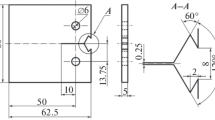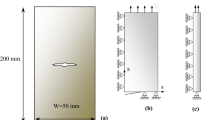Abstract
The experimental data on the fatigue lives of crack growth that were obtained in tests of aluminum specimens with overloads and underloads in the region of near-threshold crack growth rates are compared. The fatigue crack growth time is predicted using various models, including those embedded in the NASGRO and FASTRAN software packages, in order to reveal the model that is the best for calculating the fatigue life. The results obtained are compared with the prediction of a proposed combined model, which takes into account crack closure and the local stresses in the crack mouth and is based on the Neuber and Ramberg–Osgood equations. The efficiencies of the existing and proposed models used to describe the growth of fatigue cracks during random loading are estimated.

Similar content being viewed by others
Notes
Russ. Metall. (Metally), No. 11, 945–952 (2018).
Russ. Metall. (Metally), No. 5, 406–412 (2019).
REFERENCES
K. D. Singh, M. T. Parry, and I. Sinclair, “A short summary on finite element modelling of fatigue crack closure,” J. Mech. Sci. Technol. 25 (12), 3015–3024 (2011).
Q. Wang, W. Zhang, and S. Jiang, “Fatigue life prediction based on crack closure and equivalent initial flaw size,” Materials 8 (10), 7145–7160 (2015).
P. C. Paris and F. Erdogan, “A critical analysis of crack propagation laws,” J. Basic Eng.; Trans., Amer. Soc. Meehan. Eng. Ser. D 85, 528–534 (1963).
K. Walker, “The effect of stress ratio during crack propagation and fatigue for 2024-T3 and 7076-T6 aluminum,” in Effect of Environment and Complex Load History on Fatigue Life (Amer. Soc. for Test. and Mater., Philadelphia, 1970), pp. 1–14.
X. Zheng and A. Manfred, “Fatigue crack propagation in steels,” Eng. Fract. Mechan. 18 (3), 965–973 (1983).
W. Elber, “The significant of fatigue crack closure,” in Damage Tolerance in Aircraft Structures (Amer. Soc. for Test. and Mater., Philadelphia, 1971), pp. 230–242.
J. M. Barsom, “Fatigue crack growth under variable amplitude loading in various bridge steels,” in Fatigue Crack Growth under Spectrum Loads (Amer. Soc. for Test. and Mater., Philadelphia, 1976), pp. 217–235.
O. E. Wheeler, “Spectrum loading and crack growth,” J. Basic Eng. 94, 181–186 (1972).
J. D. Willenborg, R. M. Engle, Jr., and H. A. Wood, A Crack-Growth Retardation Model Using an Effective Stress Concept. Report AFFDL-TM71-1FBR (Air Force Flight Dynamic Laboratory, Dayton, 1974).
E. M. Morozov, A. Yu. Muizemnek, and A. S. Shadskii, ANSYS in Engineer Hands: Fracture Mechanics (LENAND, Moscow, 2010).
J. Maierhofer, R. Pippan, and H.-P. Gänser, “Modified NASGRO equation for physically short cracks,” Int. J. Fatigue 59, 200–207 (2014).
J. C. Newman, Jr., FASTRAN-II—A Fatigue Crack Growth Structural Analysis Program. NASA Tech. Memorandum 104159 (Langley Research Centre, Hampton, 1992).
Funding
This work was supported by the Russian Foundation for Basic Research (project no. 17-08-01648 A) and the President of the Russian Federation (grant no. MK-943.2017.8).
Author information
Authors and Affiliations
Corresponding author
Additional information
Translated by K. Shakhlevich
Rights and permissions
About this article
Cite this article
Savkin, A.N., Sunder, R., Andronik, A.V. et al. Effect of Overload on the Near-Threshold Fatigue Crack Growth Rate in a 2024-T3 Aluminum Alloy: III. Analysis of the Efficiency of the Fatigue Crack Growth Models Used to Predict the Fatigue Life under Alternating Loading. Russ. Metall. 2020, 193–197 (2020). https://doi.org/10.1134/S0036029520030106
Received:
Revised:
Accepted:
Published:
Issue Date:
DOI: https://doi.org/10.1134/S0036029520030106




